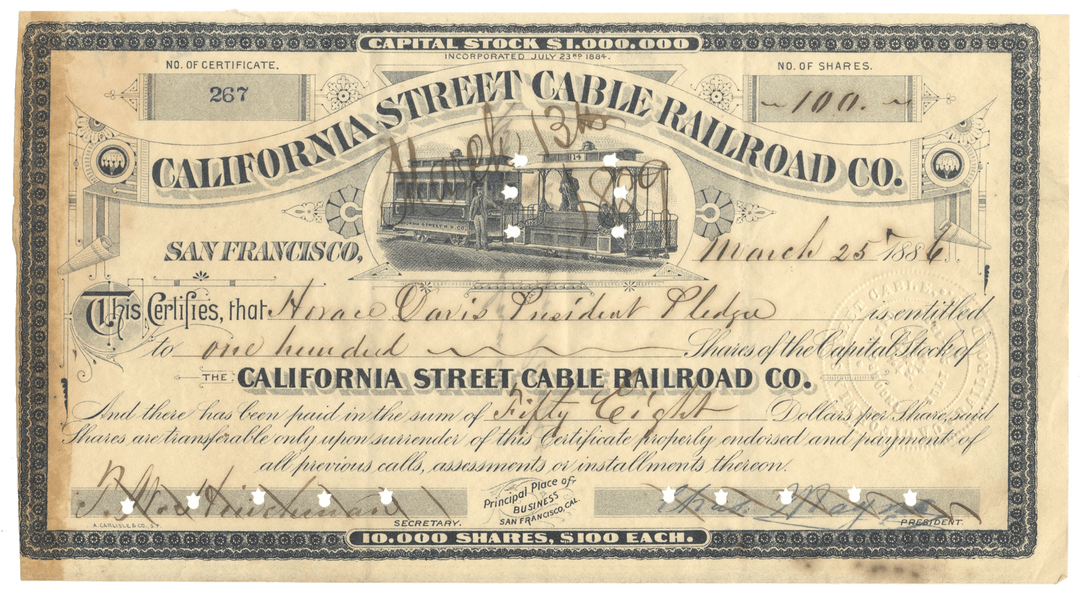
California Street Cable Railroad Co.
- Guaranteed authentic document
- Orders over $75 ship FREE to U. S. addresses
Product Details
Company
California Street Cable Railroad Co.
Certificate Type
Capital Stock
Date Issued
March 25, 1886
Canceled
Yes
Printer
A. Carlisle & Co.
Signatures
Hand signed
Approximate Size
10 1/4" (w) by 5 1/4" (h)
Images
Show the exact certificate you will receive
Guaranteed Authentic
Yes
Additional Details
NA
Historical Context
Leland Stanford, along with “Big Four” member Mark Hopkins and other prominent businessmen, created the California Street Cable Railroad Company, to open a line up Calfornia Street where he and other Bonanza Kings were building their palatial mansions. Stanford obtained a franchise in 1876 and turned construction over to one of his engineers from the Central Pacific, Henry Root. In spite of his attempts to circumvent Hallidie’s patents, Stanford was forced to pay $30,000 dollars to Hallidie for patent licensing fees, to his great chagrin.
Construction of the line began on July 5, 1877 and finished five months later, covering 1.7 miles on both sides of California Street, downtown from Kearny, up over Nob Hill past Nabob palaces, to Fillmore Street in the Western Addition. Opening of the line was delayed by other problems until April 10, 1878, on which day the line served over 11,000 riders.
In Spring of 1879, the line was extended west from Fillmore to Presidio Avenue, opening for business in May 1879. The extension, which had been cheaply built at Stanford’s order, had to be refurbished in 1884, the same year Stanford sold his interest to a local banker, Antoine Borel. Borel and James Stetson, the company president, improved and extended the line, installing new machinery in the powerhouse that reduced travel time on the line to a total of 18 minutes, down from 21.5.
In 1880 the California Street R. R. Co. in collaboration with John L. Hammond & co., a well-known local car builder, developed the California—Type Car. This car in use today on California Street combined the dummy and trailer into one unit capable of being operated from either end. Then, in 1889, Borel and Stetson proposed extending the California Street route east all the way to Market Street, and construct a new crosstown line on O’Farrell, Jones, and Hyde Streets. The California Street extension opened in 1890, and the O’Farrell, Jones, and Hyde line was ready for service in February 1891. A smaller car, the Jones Street Shuttle, ran on a short line from the junction of Market, Jones and McAllister up Turk, Eddy and Ellis Streets to meet the main line at O’Farrell Street. The company powerhouse was relocated to the corner of California and Hyde, to accommodate the new lines. This would be the last cable car line built in San Francisco.
The California Cable Railroad proved financially successful, even after electric trolleys replaced other lines, since the steep grades on California Street made conversion to electricity impractical. California Cable remained an independent company and its profitability continued well on into the 20th century (becoming part of the Municipal Railway of San Francisco in 1952), long after most of the other lines were only a faint memory.
Related Collections
Additional Information
Certificates carry no value on any of today's financial indexes and no transfer of ownership is implied. All items offered are collectible in nature only. So, you can frame them, but you can't cash them in!
All of our pieces are original - we do not sell reproductions. If you ever find out that one of our pieces is not authentic, you may return it for a full refund of the purchase price and any associated shipping charges.





